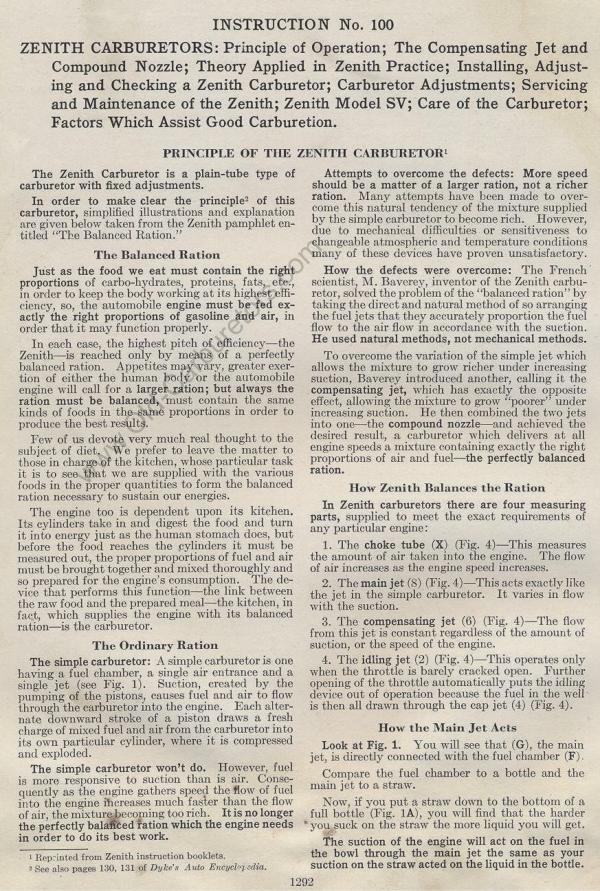ZENITH CARBURETORS:
Principle of Operation; The Compensating Jet
and Compound Nozzle; Theory Applied in Zenith Practice; Installing,
Adjusting and Checking a Zenith Carburetor; Carburetor Adjustments;
Servicing and Maintenance of the Zenith; Zenith Model SV; Care
of the Carburetor; Factors Which Assist Good Carburetion.
PRINCIPLE OF THE ZENITH CARBURETOR
The Zenith Carburetor is a plain-tube type of carburetor with
fixed adjustments.
In order to make clear the principle' of this carburetor, simplified
illustrations and explanation are given below taken from the Zenith
pamphlet en-titled "The Balanced Ration."
The Balanced Ration
Just as the food we eat must contain the right proportions of carbohydrates,
proteins, fats, etc., in order to keep the body working at its
highest efficiency, so, the automobile engine must be fed exactly
the right proportions of gasoline and air, in order that it may
function properly.
In each case, the highest pitch of efficiency—the Zenith —is
reached only by means of a perfectly balanced ration. Appetites
may vary, greater exertion of either the human body or the automobile
engine will call for a larger ration; but always the ration must
be balanced, must contain the same kinds of foods in the same proportions
in order to produce the best results.
Few of us devote very much real thought to the subject of diet.
We prefer to leave the matter to those in charge of the kitchen,
whose particular task it is to see that we are supplied with the
various foods in the proper quantities to form the balanced ration
necessary to sustain our energies.
The engine too is dependent upon its kitchen. Its cylinders take
in and digest the food and turn it into energy just as the human
stomach does, but before the food reaches the cylinders it must
be measured out, the proper proportions of fuel and air must be
brought together and mixed thoroughly and so prepared for the engine's
consumption. The de-vice that performs this function—the
link between the raw food and the prepared meal—the kitchen,
in fact, which supplies the engine with its balanced ration—is
the carburetor.
The Ordinary Ration
The simple carburetor: A simple carburetor is one having a fuel
chamber, a single air entrance and a single jet (see Fig. 1). Suction,
created by the pumping of the pistons, causes fuel and air to flow
through the carburetor into the engine. Each alternate downward
stroke of a piston draws a fresh charge of mixed fuel and air from
the carburetor into its own particular cylinder, where it is compressed
and exploded.
The simple carburetor won't do. However, fuel is more responsive
to suction than is air. Consequently as the engine gathers speed
the flow of fuel into the engine ihereases much faster than the
flow of air, the mixturebecoming too rich. It is no longer the
perfectly balafced `ration which the engine needs in order to do
its best work.
Attempts to overcome the defects: More speed should be a matter
of a larger ration, not a richer ration. Many attempts have been
made to over-come this natural tendency of the mixture supplied
by the simple carburetor to become rich. However, due to mechanical
difficulties or sensitiveness to changeable atmospheric and temperature
conditions many of these devices have proven unsatisfactory.
How the defects were overcome: The French scientist, M. Baverey,
inventor of the Zenith carburetor, solved the problem of the "balanced
ration" by taking the direct and natural method of so arranging
the fuel jets that they accurately proportion the fuel flow to
the air flow in accordance with the suction. He used natural methods,
not mechanical methods.
To overcome the variation of the simple jet which allows the mixture
to grow richer under increasing suction, Baverey introduced another,
calling it the compensating jet, which has exactly the opposite
effect, allowing the mixture to grow "poorer" under increasing
suction. He then combined the two jets into one—the compound
nozzle—and achieved the desired result, a carburetor which
delivers at all engine speeds a mixture containing exactly the
right proportions of air and fuel—the perfectly balanced
ration.
How Zenith Balances the Ration
In Zenith carburetors there are four measuring parts, supplied
to meet the exact requirements of any particular engine:
1. The choke tube (X) (Fig. 4)—This measures the amount of
air taken into the engine. The flow of air increases as the engine
speed increases.
2. The main jet (8) (Fig. 4)—This acts exactly like the jet
in the simple carburetor. It varies in flow with the suction.
3. The compensating jet (6) (Fig. 4)—The flow from this jet
is constant regardless of the amount of suction, or the speed of
the engine.
4. The idling jet (2) (Fig. 4)—This operates only when the
throttle is barely cracked open. Further opening of the throttle
automatically puts the idling device out of operation because the
fuel in the well is then all drawn through the cap jet (4) (Fig.
4).
How the Main Jet Acts
Look at Fig. 1. You will see that (G), the main jet, is directly
connected with the fuel chamber (F)
Compare the fuel chamber to a bottle and the main jet to a straw.
Now, if you put a straw down to the bottom of a full bottle (Fig.
1A), you will find that the harder you suck on the straw the more
liquid you will get.
The suction of the engine will act on the fuel in
1 ltep-inted from Zenith instruction booklets. the bowl through
the main jet the same as your
see also pages 130, 131 of Dyke's Auto Encyclopedia section
on the straw acted on the liquid in the bottle.
Previous page 1927
Supplement Home Next page 
|
